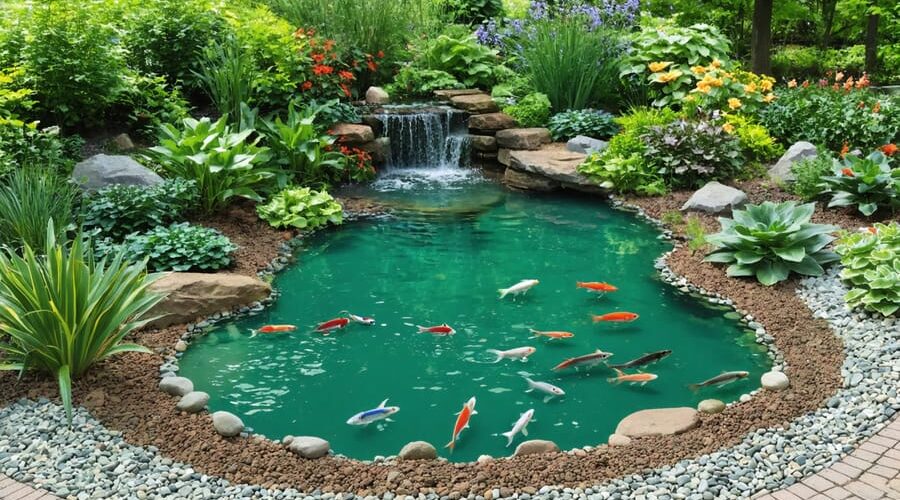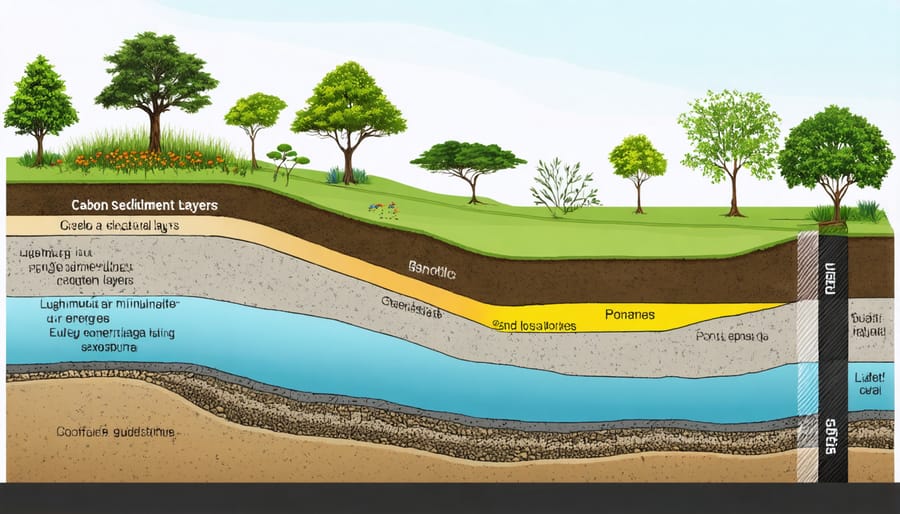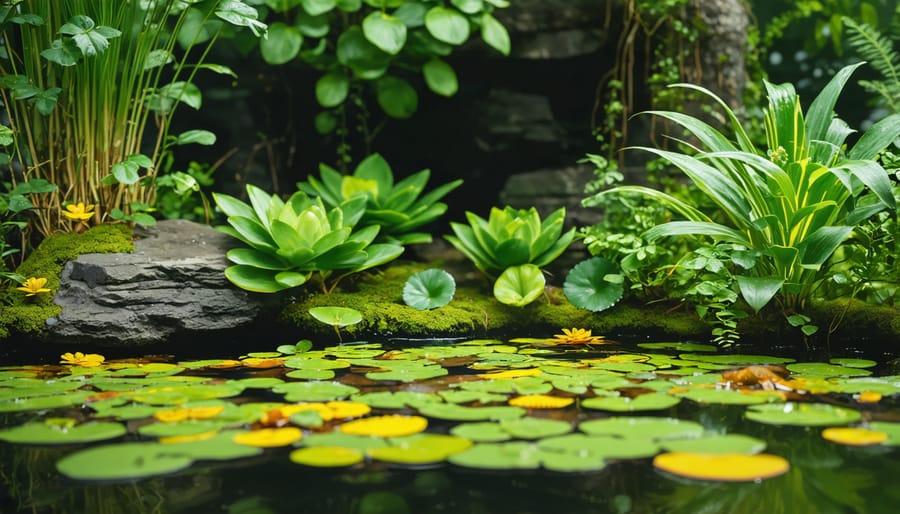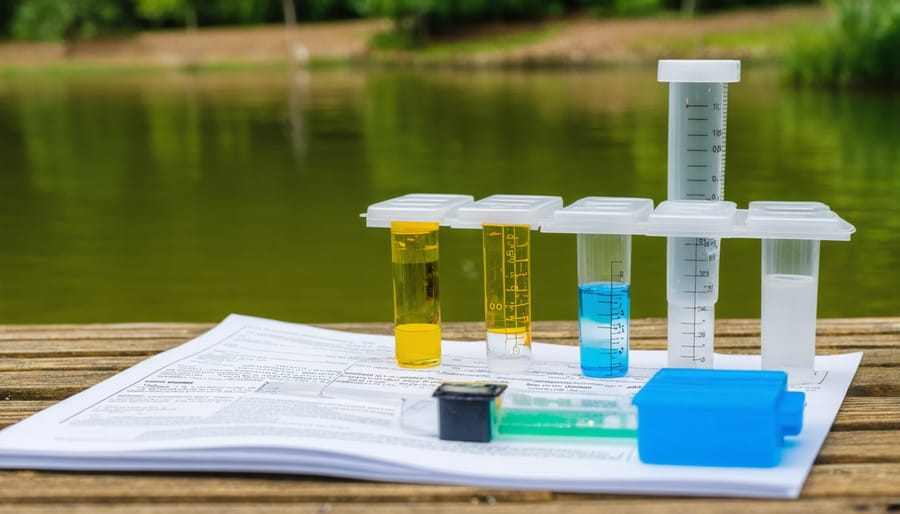
Transform Your Pond into a Natural Carbon Trap (While Boosting Fish Health)
Transform your backyard pond into a powerful tool to fight climate change through natural carbon storage. Every scoop of pond soil can lock away significant amounts of carbon dioxide, making your water feature an unexpected hero in climate action. The secret lies in the rich organic matter that accumulates at the bottom of your pond, where beneficial bacteria and aquatic plants work together to trap and store carbon naturally. By maintaining proper water depth, encouraging native aquatic vegetation, and managing organic debris, your pond becomes a miniature carbon sink while creating a thriving ecosystem for local wildlife. Best of all, these carbon-storing benefits come naturally as part of maintaining a healthy, balanced pond environment – no complex equipment or technical expertise required. Whether you’re a seasoned pond keeper or just getting started, understanding soil carbon sequestration helps you make choices that benefit both your pond’s health and our planet’s future.
How Your Pond Naturally Stores Carbon
The Hidden Power of Pond Sediments
Did you know your backyard pond is secretly helping fight climate change? The layers of muck at the bottom of your pond are actually powerful carbon storage units. As plants and algae grow in your pond, they absorb carbon dioxide from the air. When these organisms die and sink to the bottom, they take that carbon with them, where it gets buried in the sediment.
What makes pond sediments so special is how they trap carbon. The muddy bottom creates an environment with very little oxygen, which slows down decomposition. This means the carbon stays locked away instead of returning to the atmosphere. Your pond’s sediments work like a natural time capsule, storing carbon for hundreds or even thousands of years.
The deeper your pond and the more plant life it supports, the better it is at storing carbon. Even small garden ponds can make a difference. By maintaining healthy plant life and letting natural sediment build up (while keeping the pond balanced), you’re helping create a mini carbon sink right in your backyard.

Aquatic Plants: Your Carbon-Capturing Allies
Did you know your pond plants are secret carbon-capturing superheroes? Water plants like water lilies, cattails, and submerged plants like hornwort work tirelessly to absorb carbon dioxide from the atmosphere. These aquatic champions store carbon in their leaves, stems, and roots, eventually transferring it to the pond sediment when they decompose.
Floating plants like duckweed and water hyacinth are particularly effective carbon capturers, forming dense mats that quickly absorb CO2 while providing shade and habitat for pond life. Meanwhile, marginal plants like iris and rushes trap carbon not just in their visible parts but also in their extensive root systems that reach deep into the pond soil.
For the best carbon-capturing results, aim for a diverse mix of plant types in your pond. Try combining floating plants with submerged and marginal varieties. This not only maximizes carbon storage but also creates a beautiful, layered look that enhances your garden’s appeal. Remember to maintain a healthy balance – too many plants can reduce oxygen levels, while too few might limit your pond’s carbon-storing potential.
Maximizing Your Pond’s Carbon Storage Potential
Smart Plant Selection and Placement
Selecting the right plants for your pond is crucial for maximizing carbon sequestration. Understanding the crucial pond zones helps you create an efficient carbon-capturing ecosystem. Start by choosing a mix of submerged, floating, and marginal plants to ensure comprehensive carbon absorption at different water levels.
For underwater areas, consider dense-growing plants like Hornwort or Elodea, which are excellent at absorbing CO2 directly from the water. In shallow margins, opt for reed-like plants such as Rushes or Sedges, whose extensive root systems trap carbon deep in the soil.
When selecting climate-ready pond plants, focus on native species that are well-adapted to your local conditions. These plants typically develop stronger root systems and require less maintenance while effectively storing carbon.
Position taller plants like Cattails on the north side to prevent overshadowing smaller species. Create planted shelves at different depths to maximize growing space and carbon storage potential. Remember to group plants with similar water and nutrient needs together for optimal growth and maintenance.
For year-round carbon sequestration, include a mix of evergreen and deciduous species. This ensures continuous carbon capture even during dormant seasons while providing varied habitats for beneficial wildlife.

Sediment Management Techniques
Managing sediments in your pond or water feature is crucial for maintaining healthy carbon storage. The key is to create conditions that encourage organic matter to settle and remain stable at the bottom. One effective technique is to maintain proper water circulation without disturbing bottom sediments. Install pumps and fountains that create gentle surface movement rather than strong bottom currents.
Adding aquatic plants helps trap sediments naturally. Water lilies, rushes, and other rooted plants stabilize the bottom while contributing organic matter through their natural life cycle. Position plants strategically around the pond’s edges and in deeper zones to maximize their sediment-catching abilities.
Regular maintenance is essential but should be gentle. When removing debris, use a skimmer net for surface cleaning rather than disturbing bottom sediments. If you must remove bottom muck, do so sparingly and only in small sections at a time to preserve the carbon-rich layers.
Creating shallow shelves or wetland areas around your pond’s edges helps trap sediments before they enter deeper water. These areas also provide valuable habitat for beneficial microorganisms that help process organic matter.
Monitor water quality regularly, as healthy water chemistry promotes better sediment development. Maintain proper pH levels and avoid using harsh chemicals that could disrupt the natural decomposition process. Remember, healthy sediments appear dark and rich, indicating good carbon content.
Balancing Fish Populations
Fish play a fascinating role in how your pond stores carbon and cycles nutrients. Think of them as nature’s gardeners, constantly moving things around and keeping the ecosystem in balance. When fish feed, they stir up sediments and redistribute nutrients throughout the water, which helps beneficial bacteria and plants thrive.
However, too many fish can actually reduce your pond’s ability to store carbon. When fish populations get too large, they can overgraze on aquatic plants that are crucial for carbon storage. They also produce more waste, which can lead to excess nutrients and potential algae blooms.
The key is finding the right balance. A good rule of thumb is to stock about 1 inch of fish per 10 gallons of water. This allows enough fish to keep the ecosystem active while preventing overcrowding. Bottom-feeding fish like koi can be particularly helpful, as they naturally aerate the bottom sediments where much of the carbon storage happens.
Consider creating different depth zones in your pond to support various fish activities. Deeper areas provide cool refuges during hot weather, while shallow areas encourage plant growth and natural food production. This variety helps maintain a healthy fish population that contributes positively to carbon storage rather than disrupting it.
Remember to monitor your fish population regularly and adjust as needed. A balanced fish community is key to maintaining your pond’s carbon-storing potential.
Nutrient Management for Enhanced Carbon Storage
The Nitrogen-Carbon Connection
The relationship between nitrogen and carbon in your pond’s soil is like a delicate dance that affects how much carbon can be stored. When nitrogen levels are just right, plants and beneficial microorganisms thrive, helping to lock away more carbon in the soil. Think of nitrogen as the key that unlocks your soil’s potential for carbon storage.
Adding the right amount of nitrogen-rich materials, like composted leaves or aquatic plant trimmings, can boost your pond soil’s ability to hold onto carbon. However, too much nitrogen can actually work against you, causing rapid decomposition that releases stored carbon back into the atmosphere. It’s all about finding that sweet spot!
In a healthy pond ecosystem, nitrogen-fixing bacteria work alongside plant roots to create stable compounds that help trap carbon in the soil for longer periods. These helpful bacteria turn nitrogen from the air into forms that plants can use, creating a cycle that supports both plant growth and carbon storage.
You can support this process by maintaining a diverse mix of pond plants and avoiding chemical fertilizers that might disrupt the natural nitrogen cycle. Native aquatic plants are particularly good at managing nitrogen levels while contributing to carbon storage. They’ve evolved to work perfectly with local soil conditions and naturally occurring bacteria.
Keep an eye on your pond’s nitrogen levels through regular water testing, and adjust your plant management accordingly. Remember, a balanced nitrogen cycle leads to better carbon storage, creating a healthier ecosystem for all your pond’s inhabitants.
Phosphorus Balance for Optimal Results
Phosphorus plays a crucial role in soil carbon sequestration, acting as a key nutrient that supports plant growth and microbial activity. Getting the phosphorus balance right in your soil can significantly boost its carbon-storing potential while promoting healthy plant growth.
To optimize phosphorus levels for carbon sequestration, start by testing your soil. You can use simple home testing kits or send samples to a local agricultural extension office. Ideal phosphorus levels typically range between 20-30 parts per million (ppm), though this can vary depending on your soil type and what you’re growing.
Adding organic matter like compost and well-rotted manure is a natural way to increase phosphorus levels while simultaneously adding carbon to your soil. Bone meal and rock phosphate are also excellent organic sources that release phosphorus slowly, preventing nutrient runoff and maintaining steady levels over time.
However, be careful not to over-apply phosphorus, as excess amounts can harm beneficial soil microorganisms and potentially leach into waterways. If your soil test shows high phosphorus levels, focus on maintaining them through careful management rather than adding more.
Cover crops like legumes can help maintain optimal phosphorus levels naturally. These plants form partnerships with soil fungi that make phosphorus more available to other plants, creating a sustainable cycle that supports carbon sequestration.
Remember to monitor your soil’s pH, as phosphorus availability is heavily influenced by soil acidity. Maintaining a pH between 6.0 and 7.0 typically ensures good phosphorus availability while supporting the soil microbes that help store carbon.
Monitoring and Maintaining Your Carbon-Smart Pond

Simple Testing Methods
You can monitor your soil’s carbon sequestration potential using several simple methods at home. Start by examining soil color – darker soil typically indicates higher organic carbon content. Perform a basic soil structure test by digging up a small sample and checking how it crumbles. Well-structured soil with visible clumps suggests good carbon storage capacity.
The jar test is another useful method. Fill a glass jar one-third full with soil, add water, shake well, and let it settle for 24 hours. The layers that form will show your soil composition, with organic matter floating at the top. More organic matter means better carbon storage potential.
Track soil moisture using the squeeze test: grab a handful of soil and squeeze it. If it holds shape but crumbles when poked, that’s ideal for carbon storage. Too wet or dry conditions can affect carbon retention.
For a more precise measurement, weigh soil samples before and after drying them in an oven at 220°F for several hours. The weight difference indicates organic matter content, giving you a rough estimate of stored carbon.
Monitor these indicators regularly to track improvements in your soil’s carbon sequestration capacity over time.
Seasonal Maintenance Calendar
Spring (March-May):
Start by testing soil pH and adding organic amendments like compost or well-rotted manure. Plant cover crops in any bare areas and establish new perennial plants. Avoid deep tilling to preserve soil structure and existing carbon stores.
Summer (June-August):
Maintain proper moisture levels through mulching and smart irrigation practices. Add organic mulch around plants to prevent water loss and feed soil organisms. Practice minimal soil disturbance when weeding and maintain living plant cover wherever possible.
Fall (September-November):
This is prime time for carbon sequestration activities. Plant fall cover crops, add a layer of compost, and leave plant debris on the soil surface. Collect fallen leaves to create leaf mold or use as mulch. Avoid leaving soil bare over winter.
Winter (December-February):
Let the soil rest while planning next season’s activities. Monitor winter cover crops and add organic materials as they become available. Use this time to learn about new carbon-friendly practices and prepare your spring soil amendments.
Year-round practices:
– Minimize soil disturbance
– Keep soil covered
– Maintain diverse plant species
– Regular soil testing
– Document changes in soil organic matter
By implementing carbon-smart pond management techniques, you’re not just creating a beautiful water feature – you’re actively contributing to a healthier planet. From choosing the right aquatic plants to maintaining optimal water conditions, every step you take helps lock away carbon and create a thriving ecosystem. Remember, even small ponds can make a big difference in carbon sequestration when properly managed.
Start with simple changes like adding more native plants and maintaining healthy water quality. As you become more comfortable, explore advanced techniques like biochar addition or creating deeper zones. Your pond can become both a stunning focal point in your landscape and a powerful tool in the fight against climate change.
Together, we can turn our backyard ponds into natural carbon sinks while enjoying the beauty and tranquility they bring to our outdoor spaces. Why not get started today?
